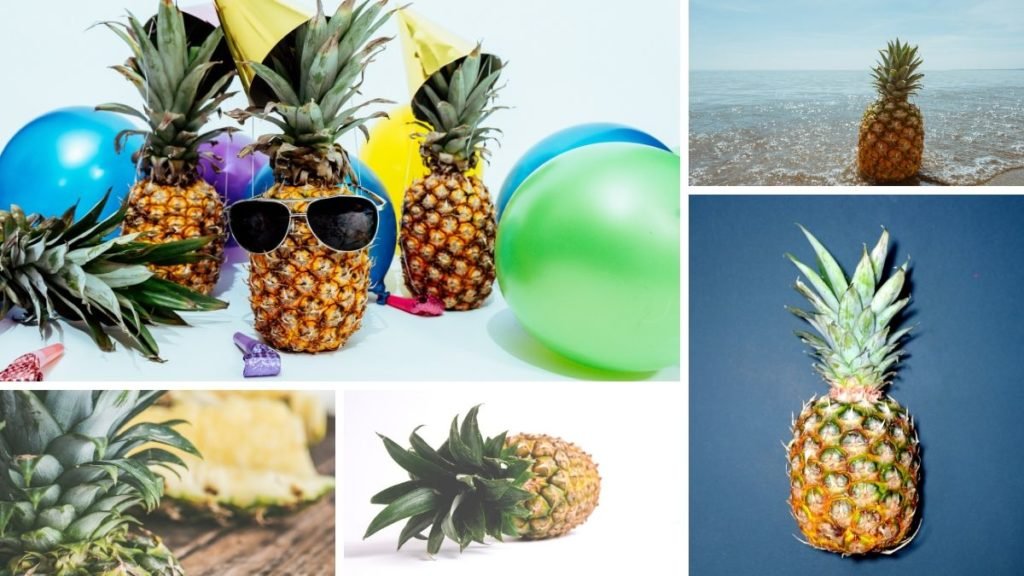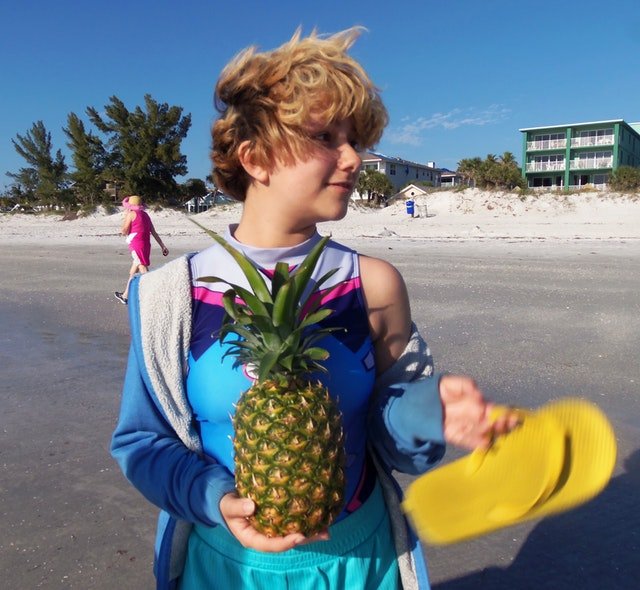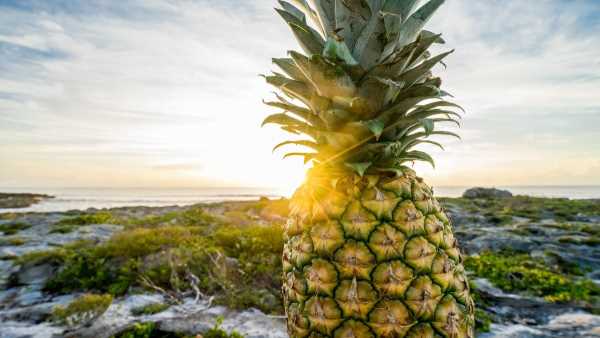
World pineapple trade figures, history, types, properties, benefits, characteristics, bromelain enzyme and more.
The pineapple, piña, or anana (we will see where these names come from) is a true prodigy of nature that amazed first the Amazonian indigenous people who cultivated and domesticated it, then the European explorers, and finally the entire world.
Today it has conquered international markets for its exquisite flavor, its medicinal properties, its bromelain and, of course, for derived drinks such as the piña colada .
Pineapple, one of the most popular tropical fruits in the world ❤️
One of the most produced and exported tropical fruits in the world is the pineapple, which ranks second, after mango, and ahead of avocado and papaya.
Of the four, only the pineapple is native to the Amazon Basin.
Although, from there it spread throughout the planet — in the beginning by the hands of Portuguese and Spanish navigators, and later, thanks to the extensive network of naturalists, researchers and merchants.
We must distinguish between the most produced fruits in the world (banana, watermelon, apple, grape, orange and mango) and the most produced tropical fruits in the world: mango, pineapple, avocado and papaya.

These four tropical fruits contributed about 7 million tons in 2017, worth close to 10,000 million dollars.
An important part of the production is consumed internally, contributing to food security, and the rest, (just over 5%) is destined for export, generating jobs and rural income and contributing to GDP growth.
These fruits are produced by farmers in small production units, less than five hectares, who live in developing countries.
However, the export sector is controlled by large transnational corporations, such as Del Monte, Dole, Fyffes, Chiquita and Banacol. Of the world production of tropical fruits, 58% comes from Asia, 25% from Latin America and the remaining 17% from Africa.
Pineapple is currently a food item that is produced and consumed all over the world.
The level of world pineapple production in 2019 was, according to figures from FAOSTAT, almost 28 million tons, a production that is concentrated 77% in just ten countries, led by Thailand, Costa Rica, Brazil, the Philippines and Indonesia. .
⚠️ Disadvantages of pineapple cultivation ⚠️
Of the four main tropical fruits, the one that presents the greatest problems for cultivation is the pineapple, because it is a non-climacteric fruit (it does not continue to ripen outside the tree), making it difficult to export as a fresh fruit because it is perishable in the short term. For this reason, it is exported as fresh fruit, in refrigerated transport, or processed. Its production is also very vulnerable to the effects of climate change (floods and droughts), and it’s unique in that it produces only one fruit a year. Weather disturbances also impact fruit production and alter its brix degree (sweetness), reducing its quality.
On the podium of tropical fruits
Pineapple ranked second in world production of tropical fruits, with a percentage of 28%, in 2017.
Most of this quota corresponded to Costa Rica, which is the second largest world producer (behind Thailand) and the world’s first exporter of fresh pineapple (destined mainly to the United States and the European Union).
Brazil is, for its part, the world’s second largest exporter, and one of the largest consumers of pineapple (Altendorf 2017; UNCTAD 2015).
A COSTA very RICH in pineapples… ☝
Costa Rica is an illustrative case of international competitiveness in the world pineapple market: it dedicates some 44,500 hectares to its production each year.
It exports about 3.2 million tons per year, equivalent to 12% of the total volume of exports, which creates a foreign exchange flow of a little more than one million dollars per year, representing 2% of its GDP.

Costa Rica has been a firm leader, maintained during the last twenty years, and has positioned itself more and more in the trade of the organic pineapple, 8% of the volume of exports, which commands between 50 to 70% higher prices than those of conventional pineapple) (Altendorf 2017).
The United States, the European Union, and Japan are the largest per capita pineapple consuming countries in the world: the United States and the European Union, with 2 kg/person/year, and Japan, with 1.3 kg/person/year.
The most consumed pineapple varieties are the Smooth Cayenne and, more and more, the MD2, considered “super sweet.”
History of the pineapple and its names
The plant was born thousands of years ago, but its modern common name emerged at the beginning of the 16th century, when the Spaniards, amazed by the shape of the fruit, called it piña, or pineapple, because it resembled the fruit of the pine tree (pinea in Latin.)
Driven by the need to call new things by some name, and wishing to reproduce the Mediterranean landscape in the New World, they began to call things by the old names they already knew. And they imposed, in daily practice, the denomination of pineapple, which spread during the colonial era, both in the empire and in the colonial territory, with some exceptions.
First detractors
Christopher Columbus found the fruit on the island of Guadalupe in 1493. They called it “piña de Indias,” but it was not a common sight for the conquerors.
Says the Report of Governor Juan de Pimentel in the Geographic Description of the province of Caracas and Government of Venezuela in 1578: “there are pineapples, very tasty and fragrant fruits, they are not considered healthy.”
It is interesting to note that the Carib Indians cultivated it on the coast of Venezuela around 1565. At that time, pineapples abounded in the Orinoco River valley. Smooth Cayenne, a widely cultivated variety today, comes from selections of cultivars that grew in the Orinoco and Amazon river basins (Leal 1989).
Pineapple and other indigenous names of the fruit
The natives called it something different: Anana, from the Caribbean word nana.
Much further into the interior of the continent, the indigenous people also called it ananá, from the Tupí, Aruaco, Chaima and Galibí languages.

In Guaraní, nana is the plant, and ananá is the fruit, from the combination of two words: a (or fruit) and nana (tasty).
Humboldt pointed out that the indigenous people of the Upper Orinoco named it “ana-curua,” similar to the Guaraní name of “naná-caraguatá” (Vélez-Boza, Valery de Vélez 1990).
The pineapple according to the General and Natural History of the Indies in 1535.
But the Spaniards of the colonial period called it piña, or pineapple. This is how Gonzalo Fernández de Oviedo records it in his General and Natural History of the Indies in 1535.
Fernández de Oviedo‘s description of the fruit is very beautiful, referring to some thistles that carry a pineapple, like an “artichoke”:
“…Since it looks like a pineapple, the Christians call them pineapples. This is one of the most beautiful fruits that I have seen in all my travels in the world.”
And then he is full of praise:
“beauty of sight, softness of smell, taste of excellent flavor. So, of the five bodily senses, the three that can be applied to the fruits, and even the fourth, which is palpation, it participates with excellence in the four things or senses above all the fruits and delicacies of the world in which men are diligently engaged in the exercise of agriculture.
Fernández de Oviedo distinguishes three species of pineapple: the boniama, the yatagua and the yayama, which he considers the tastiest of the three. He likes pineapple very much, but he says that after eating it, water or the best wine in the world does not taste good.
Spanish name vs indigenous name
From the name “piña” is derived the Spanish “piña” and the English “pineapple” (pine apple).
From the name “ananá” (from Guarani and Quechua), is derived the French, Italian and Portuguese “ananas,” and the German “Anannas.”
In Brazil they call it “abacaxi,” and in Argentina “ananá.”
The appellation ananá has crept into the most diverse languages: Dutch, Danish, Swedish and even Hindu (Rosenblat 1977).
Botanical description of the pineapple
The pineapple plant (Ananas comosus) is a triennial herb, 1 to 1.5 m tall, of the Bromeliaceae family, of which there are about 1,400 species, all herbaceous, with perennial leaves and very showy flowers.
Parts of the plant
The plant has numerous leaves grouped in a rosette, bluish-green, strong, rigid and with prickly edges.

It has a simple, erect stem, with an apex growing at the end of its upper extension, from which the fruit is born, and which ends in a crown of daughters or a plume of smaller and more showy leaves. The flowers are purple. The fruit, what we call pineapple, is actually a syncarp — that is, the fruit is formed by the set of flowers that grow around the apex. Each flower gives rise to an independent fruit, organized in a spiral around the stem. These fruits merge during fruitification to integrate the pineapple.
The united fruits appear on the outside in the form of thick “scales” known as “eyes.” The resulting syncarp is thick, with spiny bracts, large, fleshy, and yellowish in color, although there are also reddish or purple ones.
The fruit is very aromatic, with a bittersweet or sweet taste in some varieties. The reproduction of the plant is carried out, in general, from the shoots produced by the plant after its fruition.
Origin of pineapple
The primary center of origin of the pineapple (Ananas comosus) is not precisely known. It is only clear that the largest number of related wild varieties were originally located in South America.
However, specialists place it within a vast quadrilateral that encompasses Brazil, northern Argentina, and Paraguay, in the basins of the Paraná and Paraguay rivers.
But related wild species ranged as far as the Amazonian forests of Venezuela, Colombia, and the Guianas (León 1968).
Pineapple domestication in Venezuela
In Venezuela, in the Atures municipality of Amazonas state, some Amazon ecotypes of pineapple are still cultivated by members of the Piaroa indigenous ethnic group.
They grow them in their chagras, or “conucos” as they call them, using the propagule method. The method is not very convenient because it presents low rates of plant growth and slow multiplication.
These ecotypes bear fruit two years after sowing (Blanco-Flores, Vargas-Cedeño, García de García 2017). Something similar occurs with pineapple crops in the chagras of the native communities located in the Amazon trapezium, on the Colombian side (Triana-Moreno, Rodríguez, García 2006).

Pineapple, like other fruit plants, was subject to domestication processes that occurred slowly for several thousand years. This is also what happened with the caimo (Pouteria cainito), the sapote or sapota (Quararibea cordata), the pejibaye or chontaduro (Bactris gasipaes), and the caimarona grape (Pouroma cecropiaefolia), which have experienced between 1,000 and 2,000 years of domestication by the indigenous Amazonians.
Domestication was more thorough with some tuberous roots such as cassava, which has at least 4,000 years of cultivation (Kerr, Clements 1980; Arguello-Arias 1988).
Domestication of pineapple in Colombia
Pineda (1982) points out that the indigenous people of the Andoque ethnic group from the Colombian Amazon had at least ten pineapple cultivars, which suggests widespread consumption.
Some varieties needed to be cooked beforehand to be able to consume them, as was the case with the foeidí pineapple, known for having a scratchy surface.
Among the varieties cultivated by the Andoque were: the adudi (with a red epicarp like the feathers of a parrot), the batudí (whose epicarp changes color during maturation, passing through the colors green, blue, and even black), the chefadí (with a scratched epicarp), the fitiodí (with a epicarp of ashen color), foeidí (with a mesocarp or scratchy pulp), the jetsobadí (with a shape similar to the trap used by the indigenous people to catch fish), the kokocadí (or frog pineapple), the Poneidí (with a mesocarp or fibrous pulp), and the popaydí (with a white pulp like the flower of the popay) (Arguello-Arias 1988). The Tikuna, for their part, called the pineapple “ tiená ,” from which they planted two cultivars.
In the Amazonian flora there is a great richness in species, perhaps due to, among other factors, the fact that Amazonian plants have a high frequency of obligatory cross fertilization, which is why a large number of genotypes are produced in a large number of ecological niches.
Cross fertilization or allogamy consists of the transfer of pollen from one plant to another through an external pollinating agent, such as insects, birds, mammals, or vectors such as water and wind. There is also the asexual vegetative propagation by means of rhizomes, stem sprouts, root shoots, bulbs, etc., which ensures maximum preservation of the species.
The international spread of pineapple
Spanish navigators introduced the pineapple to Europe in 1535. The Spanish, English and French nobility valued it so much, eating it fresh or candied, that they recommended its cultivation to their gardeners in the 17th and 18th centuries.
For their part, the Portuguese took it from Brazil to Africa and India in the 16th century: it arrived in Goa in 1550, and in India between 1558 and 1561, although some say it was in 1545.
The pineapple arrived in Madagascar in 1548 and in Asia in the middle of the 16th century.
The Hawaiian 🤑
At the end of the 17th century, its cultivation was already implanted throughout the tropical zone and at the end of the 18th century it was introduced in Hawaii.
At the beginning of the 20th century, the United States (thanks to crops in Florida and Hawaii) had become the main producer of pineapples in the world.
The first tests of producing canned pineapples were made in Hawaii in 1882. From that successful experiment, pineapple canneries proliferated, starting in the 1920s in Asia (in Taiwan, Southeast Asia, and Malaysia), and later in Australia, South Africa, the Philippines, and Kenya (UNCTAD 2015).

Before and after…
But the pineapple that was spreading then is not like the current one, in size or flavor.
The pineapple that is now produced weighs up to two kilos, and its flavor is much sweeter, especially the MD 2 variety, known as supersweet.
It was orginally a yellow pineapple, which the Burgos doctor Cristóbal Acosta described in his Treatise on Drugs and Medicines of the East Indies, published in 1578, saying that it was a fruit that came from Brazil “the size of a small citron, very yellow, and very fragrant when ripe; and it smells so much, that in the street you know in which house it is present” (Cartay 1992; León 1968; Hill 1965; Shery 1956).
The pineapple of the Spanish chroniclers in America
The pineapple made a double diffusion trip: its physical transfer, carried mainly on ships by the Spanish and Portuguese to Europe, and from there to the rest of the world; and its documentary record, which traveled in the chronicle books of the Spanish and Portuguese priests.
There are many references to the American fauna and flora in such chronicles. The presented references of the chroniclers were taken from Cartay (1992) and Vannini de Gerulewicz (1974).
… like a turnip?
One of the first references to the pineapple was made by Michael de Cuneo in 1495: There is a fruit similar to the artichoke, like our piña, “but twice as big; it is exquisite, it is cut with the knife as if it were a turnip, and it seems to be very healthy.”
…the queen of fruits!
Peter Martyr of Angleria, around 1530, spoke of a fruit “that has many scales, and in appearance, shape and color resembles pine cones, but in its softness is like a melon, and in flavor it surpasses all orchard fruit…The king himself (Fernando) awards it the palm.”
…of the most beautiful!
Gonzalo Fernández de Oviedo, in 1535, said that “This is one of the most beautiful fruits that I have seen in all my travels in the world.”
…wow!
Fray Tomás de la Torre, around 1543, did not like it because it tasted like “overripe and sun-roasted melons.”
…mmm, tasty!!
For Girolamo Benzoni, pineapple is one “of the tastiest fruits in the world; once the rind is removed, all that remains is meat; its taste is sweet, a little acidic.”
Joseph de Acosta, around 1590, said that “it is a fruit with an excellent smell and very appetizing to eat; the flavor has a sweet and juicy sourness; eat it after soaking slices in water and salt for a while.”
The Inca Garcilaso de la Vega says that “The pineapple, with its white pith, all very tasty to eat, is touched very little by agriculture, making it more appetizing.”

Fray Antonio Caulin, who worked in the missions of eastern Venezuela in the mid-eighteenth century, said that “The pineapple is one of the best fruits that grows in America. Its pith is very sweet with a touch of sour; and it is so fragrant that due to its fragrance and beauty they usually put it on the monuments during Holy Week.”
Pineapple was the sensation fruit on the tables of the nobles of Spain. King Ferdinand of Aragon considered it excellent, although another king, Carlos V, only appreciated its smell and nothing else (Pereyra 1920: 209).
The agronomic management of pineapple
Pineapple is a perennial herbaceous plant, with a superficial root system. Its reproduction is carried out by vegetative means, by suckers, or by the crowns, although it is a slower and less productive procedure.
Crop
A plant in a commercial plantation has a cycle that lasts at least 15 months: 11 from the sowing of suckers to flowering and harvesting, and then about 4 months for the production of suckers for a new plantation.
Where to plant it. Ideal climate and soils
The pineapple plant prefers, due to its weak root system, light, aerated and well-drained soils, with a pH of 4.5 to 5.5, and a temperature equal to or greater than 25 °C.
How to plant pineapples
It is planted in furrows on raised ridges, to promote drainage and prevent root rot caused by fungi. In some parts, cultivation is practiced on gently sloping land.
Harvesting is done manually on small plantations, and by using machines on large plantations.
Types
The two most cultivated pineapple varieties are the Smooth Cayenne and, increasingly, the very sweet MD2.
MD2 is a hybrid that combines strength and consistency in size and maturity.
Of the selections made experimentally based on Smooth Cayenne, two were chosen in 1981. One of them, 73-114, became MD2, named after Mrs. Millie Dillard, wife of Frank Dillard, a great pineapple businessman (Leal 1989).
Pineapple properties / Nutritional value / carbohydrates
Pineapple fruit stands out, from a nutritional point of view, for its content of carbohydrates, vitamin C and, among minerals, potassium and iodine.
The caloric value of 100 g of pineapple is 46 to 50 calories, depending on the variety consumed. It is not a high proportion, despite its carbohydrate content (11.5 g), thanks to its high percentage of water (86 g, or 86%). It does not contain significant amounts of total fat (0.12 g) or protein (0.54 g).
Benefits / Medicinal uses / What diseases does it cure?
Its fiber content (11.2 g) makes it a kind of mild laxative. It helps reduce blood cholesterol levels and contributes to good glycemic control, which may be of interest to people with diabetes .
Additionally, due to the presence of oxalic acid in the fruit, pineapple produces a satiating effect, which may be recommended for people who suffer from high blood pressure and for those who suffer from kidney failure, or have a tendency to suffer from kidney stones.
Its contribution of vitamin C is very important for its antioxidant status and ability to reduce the risk of infections.
Its high potassium content is also one of its virtues. Potassium is necessary for the generation and transmission of nerve impulses and for muscle activity. It also intervenes in the balance of body water.
Pineapple Plant Uses
The pulp of the pineapple fruit is preferably consumed fresh, directly, or as part of fruit salads, or as an ingredient in so-called “exotic” cuisine.
If the pineapple is not fully ripe, it produces an unpleasant sensation in the mouth, as if it “cut the tongue.” This effect is due to the fact that it contains “raphides” in its cells, which are a kind of very fine calcium oxalate needles (V{elez-Boza, Valery de Vélez 1990).
Pineapple is increasingly marketed canned (in slices or chunks), as a simple juice, or as a concentrate.
From the fermented juice (from the pulp or the peel) wine or pineapple liquor and vinegar are produced.
The pulp is used as a base for making ice cream or yogurt.
Dehydrated or candied pineapple is also processed.
Bromelain enzyme
An enzyme with proteolytic action, called bromelain, is obtained from pineapple juice; it has the property of digesting amino acids from proteins and is used to facilitate proper digestion.
Bromelain was discovered in 1891 by the Venezuelan chemist and pharmacist Dr. Vicente Marcano Echenique (1848-1891). Bromelain is currently used to reduce inflammation.
Pineapple guarapo
In addition, with the pineapple peels macerated in water, a drink is obtained that is known as pineapple guarapo. In some countries such as Venezuela and Colombia, if it is left to ferment with the addition of sugar, it acquires a certain degree of alcohol. From guarapo and corn flour, the Andean chicha is also made.
The “pina colada” and who invented it?
One of the most popular cocktails derived from pineapple is the “piña colada,” which has coconut cream, white rum, and pineapple juice. The drink has many alleged “inventors.”

One of them is the Puerto Rican pirate Roberto Cofresi, who was executed in 1825.
Another was the Puerto Rican barman Ramón Portas Mingot in 1963, when he worked at Pepe Barrachina’s restaurant Barrachina. Portas made his recipe from coconut cream, pineapple juice, rum, condensed milk, and crushed ice.
In The New York Times, in the April 16, 1950 issue, a recipe appeared for the piña colada, with rum, pineapple juice, and coconut milk.
For others, the piña colada was born in Puerto Rico from a popular drink known in the 1950s as Coco-loco, which originally contained coconut cream, coconut milk, and rum.
The barman Ricardo Gracia, who worked at the Hilton Hotel in San Juan, had the idea of putting the drink in a cut and pulped pineapple. According to that version, the piña colada was born when it was mixed with pieces of fresh pineapple.
Pina colada recipe
Now, the classic formula has 3 cl of white rum, 3 cl of coconut cream, and 9 cl of pineapple juice, which is mixed in a blender or shaker with crushed ice. If it does not contain rum, it is called a virgin piña colada.
Other uses of pineapple
Pineapple leaves are used to feed livestock, and their fiber is used as a raw material for the paper industry or for clothing, or ground for the production of biogas.
In addition, experiments have been carried out for the use of pineapple peel (and also the crown of the fruit) that can be ensiled with a mixture of urea and hay to form a high-quality forage for ruminant feeding, with a shelf life of about six months (Elizondo-Salazar, Campos-Granados 2014).
BIBLIOGRAPHY .
- Altendorf S. (2017). World prospects of the main tropical fruits. Rome: FAO. PDF
- Arguello-Arias H. (1988). Agricultural practices and genetic consequences that allow a better adaptation of indigenous people to the Colombian Amazon. Colombian Agronomy, Vol. 5 (1-2). 86-96. PDF
- Blanco-Flores HA, Vargas-Cedeño TE, García de García EC (2017). In vitro regeneration of pineapple plants ( Ananas comosus) Gobernadora Amazonian ecotype. Colombian Journal of Biotechnology. Vol. 19 (1), 7-20. PDF
- Cartay R. (1992). Food history of the New World. San Cristobal: Editorial Future. 2nd. ed. Source
- Closed I. (2013). Marketing parameters of MD2 pineapple in the main Honduran markets. CEDIA. Source
- Elizondo-Salazar, J.A., Capos-Granados, C.M. (2014). Nutritional characteristics of pineapple husk ensiled with increasing amounts of urea and hay. Tropical Animal Nutrition, 8(2), 51-71. PDF
- Fernandez de Oviedo G. (1959) 1535. General and Natural History of the Indies. Madrid: Atlas Editions. 2 vols. Source
- Hill AF (1965). Economic Botany. Barcelona: Omega Editions.
- Loyal F. (1989). On the history, origin and taxonomy of the pineapple. Interciencia, 14 (5), 235-241, September-October. Source
- Leon J. (1968). Botanical foundations of tropical crops. San José, Costa Rica: IICA-OAS. PDF
- Montilla de Bravo, I. (1997). Pineapple cultivation in Venezuela. Barquisimeto: Venezuela: Lara State Agricultural Research Center. National Fund for Agricultural Research. Source
- Pimentel J. of. Geographic relationship and description of the province of Caracas and the Government of Venezuela. 1578. (1927). Bowl. Aad. born Of history. Us. 39 and 40. Caracas. PDF
- Pineda R. (1982). Chagras and hunting of the rubber heron. Andoque horticultural system. Colombian Amazon. Bogotá: DRAM Publications Committee, 1-57. PDF
- Rosenblat A. (1977). The conquerors and their language. Caracas: Central University of Venezuela. Source
- Schery R.W. (1956). Plants useful to man (Economic Botany). Barcelona: Salvat Publishers.
- Triana-Moreno LA, Rodriguez VC, Garcia J. (2006). Dynamics of the chagra agroforestry system as the axis of indigenous production in the Amazonian Trapeze (Colombia). Colombian Amazon, Vol. 24 (1), January-June, 158-169. PDF
- UNCTAD (2015). Pineapple. Geneva: UNCTAD. PDF
- Vannini de Gerulewicz, M. (1974). The Sea of Discoverers. Caracas: III United Nations Conference on the Law of the Sea. Source
- Velez-Boza F., Valery de Boza, G. (1990). Food plants of Venezuela. Caracas: Bigott Foundation/ La Salle Society of Natural Sciences. Source

Dr. Rafael Cartay is a Venezuelan economist, historian, and writer best known for his extensive work in gastronomy, and has received the National Nutrition Award, Gourmand World Cookbook Award, Best Kitchen Dictionary, and The Great Gold Fork. He began his research on the Amazon in 2014 and lived in Iquitos during 2015, where he wrote The Peruvian Amazon Table (2016), the Dictionary of Food and Cuisine of the Amazon Basin (2020), and the online portal delAmazonas.com, of which he is co-founder and main writer. Books by Rafael Cartay can be found on Amazon.com
This post is also available in:
![]() Español (Spanish)
Español (Spanish)
